Not long ago, if you asked someone in the music industry about Pandora, you’d get an earful about aggressive attempts to pay lower royalties. Now, their not paying much more than they always did; but most would give the streamer a thumbs up. That shift is largely because artist-friendly founder Tim Westergren took control and launched a series of musician and music industry friendly initiatives.
______________________________________
By Glenn Peoples, Music Insights and Analytics at Pandora
The recorded music industry is like a boulder on a hill. Pushing the boulder up the hill is difficult even during the best of times. When new formats and technologies spur periods of transition, the boulder gets heavier, the hill gets steeper, and the industry retreats a few steps. That’s what has happened in the U.S. music industry over the last dozen or so years. But in the past couple years, the boulder has reversed course, the ground has become steadier and the CD-to-download-to-streaming transition has become smoother. Revenues are rising in the U.S. and around the world. Business models are evolving and taking shape. New products are being launched. Now the boulder doesn’t seem so heavy.
What did Pandora do to help push the music industry forward in 2016? Plenty. The year was marked by the launch of forward-thinking products, unique content and landmark agreements with rights holders. More information on each item is below, but here’s the list of ten ways Pandora is helping the music industry evolve and improve: direct licensing agreements with record labels, Pandora Premium, Pandora Plus and offline listening, a replay function, Thumbprint Radio, the Ticketfly integration with Pandora, the Questlove Supreme show, the This American Life podcast and the Next Big Sound charts.

DIRECT LICENSING DEALS WITH RECORD LABELS
In September, Pandora announced it signed direct licensing agreements with Universal Music Group, Sony Music, Warner Music Group and Merlin Network. These were landmark deals that have allowed Pandora to build new products that introduce new features and guide the company into a new era. Three items on this list are the direct result of these deals. First is the upcoming launch of Pandora Premium, the new $9.99-per-month, premium service with on-demand features. The arrival of Pandora Premium brings a strong competitor to an on-demand market that had an 83-percent growth in streams last year, according to BuzzAngle.
Two innovative, first-to-market features for Pandora’s core radio products are also the results of the new deals: offline listening for Pandora Plus and a replay function on both Pandora Plus and the free, ad-supported Pandora service (more on those below). These licensing deals — they cover the use of labels’ sound recordings — follow the direct licensing deals Pandora signed in late 2015 with both small and large music publishers as well as performing rights organizations ASCAP and BMI.
On a separate but related note, the direct deals give artists and rights holders increased royalty rates across all three tiers.
[A side note: Four years ago Pandora had no direct licenses, no industry relations team, and was boggled down in a public dispute with trade groups representing artists and rights holders. But not long after, the earliest of high-level licensing talks began, an industry relations team began to take shape (see proof in the late January Billboard cover story) and Pandora began work on preparing itself for its next phase.]
How it moves the industry forward: Better, more innovative services will help expand the premium streaming market. New features will raise the bar for what consumers expect from services.
PANDORA PREMIUM
Pandora Premium addresses what for years have been premium services’ biggest problems: the intimidation and complexity of premium music services. Entering an on-demand service—those on-demand, unlimited-listening-for-$9.99-a-month services — can be like walking into a museum the size of ten airplane hangers with a nearly indecipherable map and a half-blind guide. A user requires help to enjoy a large catalog of songs. Curators and editors are often employed by these services. They also get automated recommendations. Some people actually invest the time and energy to endlessly perform the digital equivalent of crate-digging for choice vinyl records.
Pandora Premium takes a very “Pandora” approach to the premium service with a personalized product that does the heavy lifting for the listener. The service leverages its trove of listener data and uses the Music Genome Project, a taxonomy of the songs in its catalog, to recommend and select songs. People have thumbed songs on Pandora for years—some for a decade or so—and those thumbs help Premium create radio stations, recommend new music, and suggest and create playlists of favorite artist and genres. One particularly helpful feature, “add similar songs,” automatically adds five songs a playlist with the press of a button. Press it again and five more songs are added. Easy. And like the existing Pandora service, Premium has a personalized browse feature for finding new music, playlists and artists. Also easy.
How it moves the industry forward: Pandora Premium is a unique take on giving people music they like and music they don’t yet know they like. In a competitive field, Pandora has a differentiated product that can leverage a listener base of over 78 million monthly listeners.
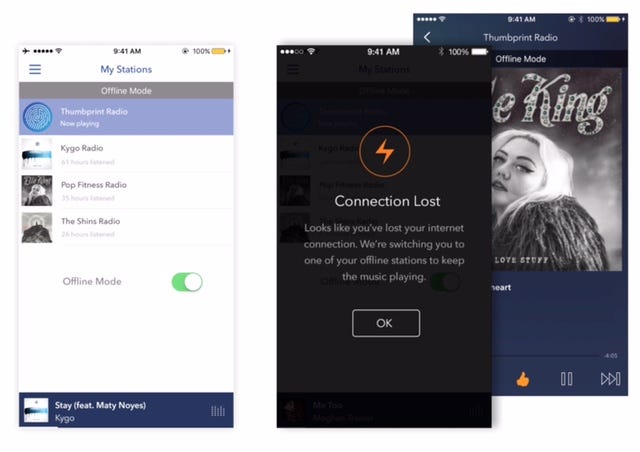
PANDORA PLUS AND OFFLINE LISTENING
Until September, digital radio was a live-in-the-moment experience. Just like broadcast radio, digital radio services could stream music but couldn’t download it; as required by the standard license, services must limit the number of times a person could skip a song and couldn’t allow replays. Pandora’s direct licensing deals birthed Pandora Plus, the update and rebrand of the long-running Pandora One ad free, subscription radio service.
One new feature is offline listening, a first for a non-interactive digital radio service. Plus automatically downloads the songs of a user’s three favorite channels plus their Thumbprint Radio station. New York City subway riders, drivers through cellular dead zones in Los Angeles, and frequent air travelers will appreciate the automatic downloads. The other feature is unlimited skips. Pandora One limited the number of times a user could skip songs. Because of new licensing deals, Pandora Plus doesn’t limit the number of skips on iOS and Android devices. The ad-supported, free service also gets an improved skip policy. When free listeners hit their skip limit they can unlock additional skips by engaging with an ad.
How it moves the industry forward: Better features lead to better products and a better listening experience. Better products provide more value to consumers. Premium services must always innovate for the music subscription market to reach critical mass.
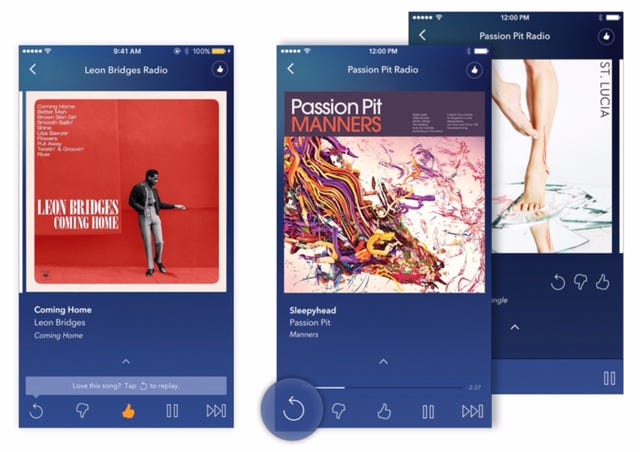
SONG REPLAYS
Going back over ten years, the main Pandora radio service had been totally non-interactive. A listener could skip a track or thumb a song, but a specific song could neither be played on-demand nor replayed. You listened, you thumbed and you skipped. Skip forward to September 2016 and the direct licensing agreements (see above) enabled Pandora to create a replay feature for both the free, ad-supported service and Pandora Plus. This is a big moment in music streaming. It’s a delightful addition for listeners who can’t bear the wait a traditional digital radio service imposes on hearing a song twice. Pandora Plus subscribers get to replay songs in their listening history (swipe to the right). Free listeners get a reply by watching a video ad.
How it moves the industry forward: Replays is a first-to-market, interactive feature for an otherwise non-interactive radio service. Finally, listeners can repeat a song they love.
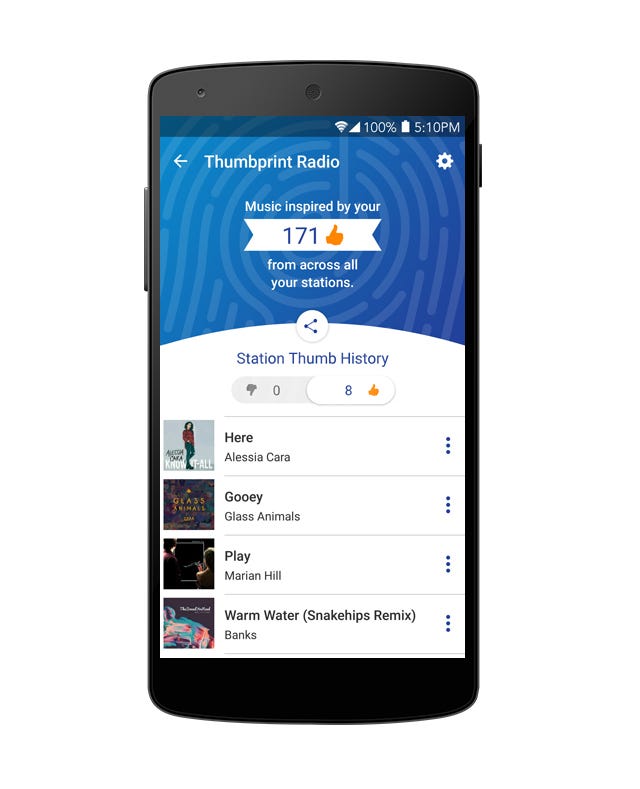
THUMBPRINT RADIO
Thumbprint Radio, launched in December 2015, has been called “the most popular radio station in the world.” That’s a bold claim for a new feature of just one digital radio service but the numbers back it up. Through January, the year-old station had 9.2 billion spins by 28 million listeners—at just one station. There’s a good reason so many people are listening. The aptly-named Thumbprint Radio gives each listener a station based on songs they’ve thumbed on Pandora. If a Thumbprint Radio station could be called “Joe’s Greatest Hits,” for example, it would spin songs Joe has thumbed in the past and songs he is sure to like now. The result is a thoughtful — if that word can apply to algorithms — selection of familiar songs that span the user’s listening history.
A listener will notice how the songs easily flow from one genre to the next. A group of metal songs might be followed by downtempo electronic songs, thumping indie rock songs and then a group of West African afro-funk tracks. This is real progress. When the iPod was released in 2001, people could mix their MP3 collection with the iPod’s shuffle feature. [A dozen years ago, people so loved to shuffle songs in their MP3 collections that Apple released in 2005 the iPod shuffle, a small, screen-less music player that could only shuffle songs.] Sure, shuffle gave people songs people liked, but it was a disjointed experience that could jolt the listener when Metallica was followed by Norah Jones. This kind of listening experience, first a drunken walk through a music collection, then a poorly guided tour, has been improved over the last 12 years as recommendation engines became more prevalent. Now there’s Thumbprint Radio, the best way to hear songs you already know you like.
How it moves the industry forward: Thumbprint Radio is the best of the “guided tour” types of radio stations and ups the ante for delivering a better listening experience.
TICKETFLY INTEGRATION
Hear a song and seconds later purchase a ticket to an upcoming show — without leaving the app. It wasn’t possible before Pandora’s acquisition of Ticketfly and the technology integration that allows Pandora to use its platform to sell concert tickets. The combination of services give the Pandora listener has a simple route — perhaps the simplest path — from learning about a concert to buying a ticket. (If you haven’t gone into your Pandora app’s feed, you’re probably missing concert announcements and ticket offers—some by Ticketfly venues—that show how frictionless this process really is.) From the ticket sellers’ points of view, the integration provides tools to promote concerts and sell tickets. Artists can use Pandora’s Artist Marketing Platform (more on that below) to promote upcoming shows by recording an audio message that’s streamed to fans listening to their Pandora station. The listener hasn’t seen much of the Ticketfly integration but will notice more in 2017. 2016 was a year of hard work integrating the two platforms.
How it moves the industry forward: For the music industry, the addition of Ticketfly creates a more diverse, more powerful partner in Pandora. Taking a wider view, stacking Ticketfly onto Pandora changes the thinking about what a standalone streaming service can be.
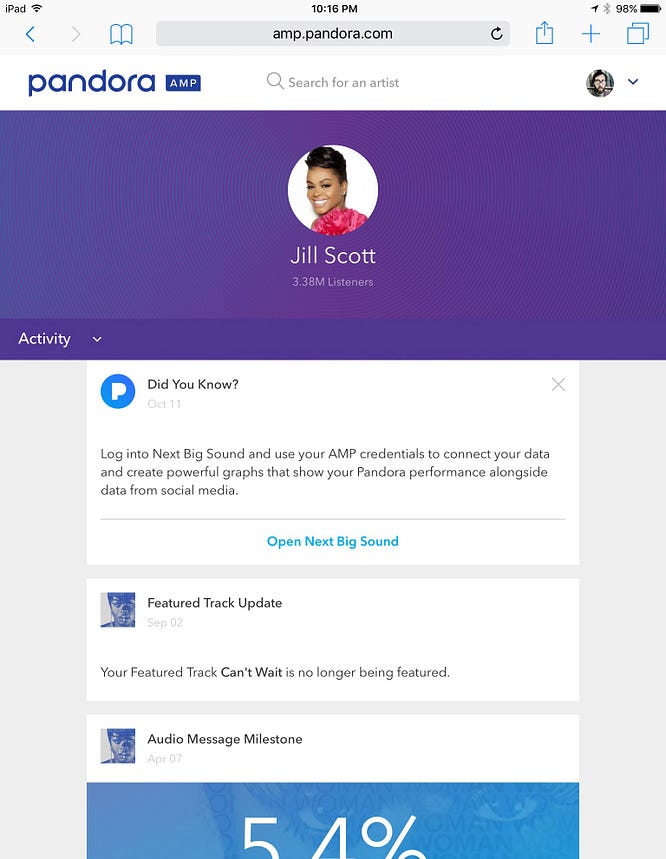
ARTIST MARKETING PLATFORM (AMP)
It’s common for artists and managers to look at a streaming service and ask, “What else can you do for me?” Provide information? Help promote, market and sell things? Pandora can say, “Yes, yes and yes.” The Artist Marketing Platform, simply called AMP, launched in 2014 and was updated in October with more features and a cleaner layout. Other tools exist to help artists market, promote and sell, but nothing else reaches such a large number of fans in this way. Not only can AMP help artists sell concert tickets (see above paragraph) it also offers tools that builds campaigns and analyzes their effectiveness. A new feature allows artists to record audio messages—this can also be done on the mobile app, AMPcast—and stream them to fans across the nation or in specific markets. Campaigns built around artist audio message, as they’re called, are good for planning a tour and targeting fans in specific markets. Artists also have the ability to choose a “featured track” that gets accelerated spins to reach more listeners. The potential reach of these audio messages may surprise people because an artist can have far more Pandora stations than followers on social media. Just as an example, Bon Jovi has 5.7 million Pandora artist stations compared to 2.4 million Twitter followers.
How it moves the industry forward: AMP sets a new standard for free artists tools offered by a music streaming service.
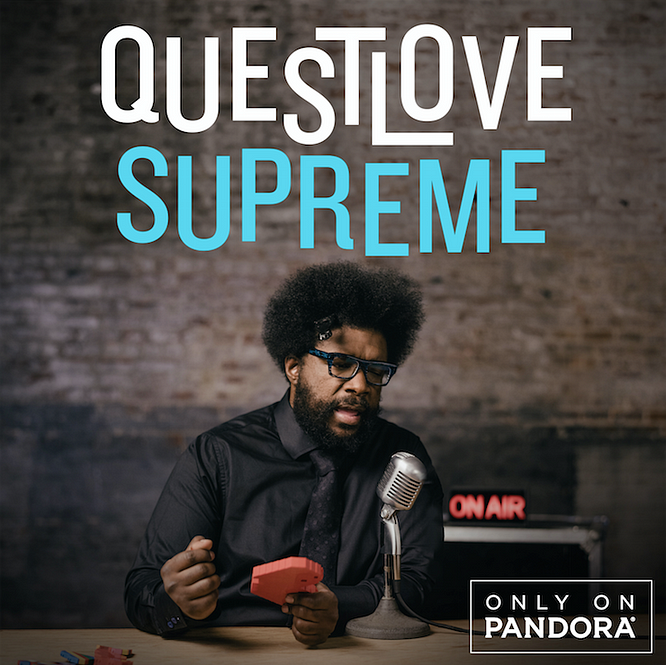
QUESTLOVE SUPREME
Questlove was a big get for Pandora. His show, Questlove Supreme, combines interviews, humor, and music that reflect the tastes of it host, the drummer for The Roots, pop culture icon, NYU professor and a tastemaker of the highest regard, Questlove. Listeners get to hear Questlove chat and trade witticisms with guests (Maya Rudolph, Solange, Purple Jewels, Shep Gordon, Q-Tip, and The Revolution, among others) while spinning familiar songs and unearthing rarer ones. Consequence of Sound summed it up well by calling the show it “a music junkie’s dream” for the “handpicked mixtape of Questlove-approved jams.” Each week’s three-hour episode debuts on Wednesdays. Aside from the show itself, Questlove Supreme is also unique from a business angle because the host is a strategic advisor to Pandora and its first artist ambassador.
How it moves the industry forward: Shows like this, and a household name like this, broaden the role and identity of a streaming service. Offering more great content can only help attract listeners, keep them listening and bring them back.
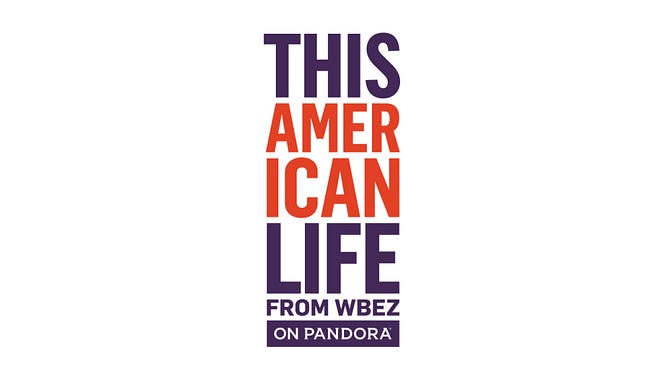
THIS AMERICAN LIFE
The definition of a music streaming service is breaking apart. Pandora got into the podcast business in 2015 by becoming the exclusive streaming partner of the immensely popular Serial podcast. Last year, Pandora took another step into podcasts and began streaming This American Life, the long-running public radio show heard by over 2.2 million people every week. (Serial, a podcast sensation not available on broadcast radio, was a spinoff of This American Life.) On Pandora, This American Life had 28 million episode streams through mid-January. One important facet of Pandora’s approach to podcasts is their visibility. Pandora greeted the show with fanfare and wide media coverage. At Pandora the show has its own station page where listeners can choose from older episodes as well as segments within episodes. It’s a fresh way to hear a 21-year-old classic.
How it moved the industry forward: See above. See above. Great content and household names—at least in the homes of regular NPR listeners—broaden a streaming service and give people another reason to listen and, if all goes well, subscribe, too.
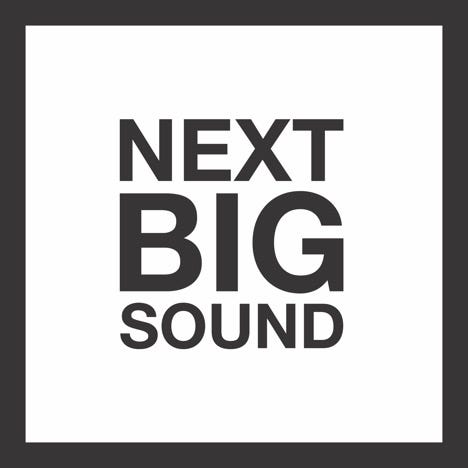
NEXT BIG SOUND CHARTS
In August, Pandora debuted three charts from Next Big Sound, the Pandora-owned music data and analytics company: Pandora Predictions, Pandora Trendsetters and Pandora Top Spins. Each chart highlights artists at different spots in their careers and levels of popularity. Each adds insights and different perspectives on what artists and songs are connecting with listeners. (For editorial insights, see Next Big Sound’s blog with data-driven writings.) Pandora Predictions is based on social media activity and has up-and-coming artists that haven’t landed on a major Billboard chart (Hot 100, Billboard 200, Country Airplay, et al). Pandora Trendsetters tracks the social activity and Pandora spins of artists in the early stages of their careers. Pandora Top Spins ranks songs by Pandora spins. There are numerous scenarios for using these charts. A&R reps can use Pandora Predictions to track unsigned artists. People in and out of the industry can look to Pandora Trendsetters for the artists of tomorrow and Pandora Top Spins to see how the most popular artists are resonating with listeners.
How it moves the industry forward: The industry benefits from new charts that provide a different look at the music industry. The Pandora Spins chart is especially vital because it reveals the top songs at the country’s most popular digital radio service.